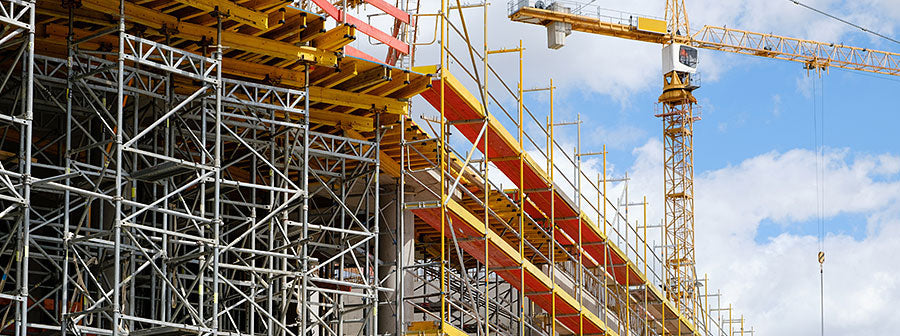Did you know that scaffolding is as ancient as cave paintings? The first evidence of scaffolding being used is in the oldest cave painting site in the world: Lascaux. Scaffolding has come a long way since then, making pit stops in Ancient Greece and Ancient Egypt. Today, scaffolding is a vital aspect of working at heights. Read along with us at WRYKER to find out how to properly use scaffolding!
We have talked about falls before here at WRYKER's Toolbox Talks blog, and there is no shame in repeating: “falls are the leading cause of death in construction." They account for nearly 32% of all construction deaths. We all need to do our part to better educate ourselves and save lives. Scaffolding is used by 65% of construction workers every year. Read on for tips on how to use scaffolding and mitigate hazards.
What is Scaffolding?
Scaffolding is a system built around a building or bridge that helps construction workers build and repair said structures. They are used at height to help workers gain access to hard to reach areas. Scaffolding is incredibly useful. Without it, we would not be able to adequately repair our tall structures. However, it needs to be used carefully, correctly and appropriately to prevent falls and, in the worst cases, death.
How to Safely Use Scaffolding
Before erecting and using scaffolding on any jobsite, you must have an appropriately trained professional to guide the project. This competent person's training must incorporate information about hazards such as electrocutions, falls, falling objects and the proper procedures for managing such hazards. Training must be up to date, and if your training was many years ago or you have forgotten any of the material, simply ask a supervisor for additional training. It is in both the employees and employers best interest to provide training to make the jobsite as safe as possible. Reduced risk of an accident is good for everyone involved!
Scaffolding must be erected very cautiously by a competent person. It is best to use all parts from the same manufacturer, but a competent person may decide that components from other systems are acceptable to use. A good rule of thumb when choosing whether to use different components is that they must fit together without force. A component person must inspect the scaffolding before it is used.

Scaffolds should be planked whenever possible. It is vital to use scaffold grade lumber for planking to ensure safety and load capacity. Platforms should be 18 inches wide. A scaffold must also be carefully secured to the building:
- at least every 30 feet horizontally if the scaffold’s height is larger than four times its width
- at least every 20 feet vertically if the scaffold is three feet wide or less
- at least every 26 feet vertically if the scaffold is wider than three feet
Scaffolding should be placed on solid ground, free of sand, loose rocks, or other unstable materials. If you are using scaffolding on any uneven ground, you must use mudsill and base plate screw jacks. They provide a level firm foundation on which to use scaffolding. You don’t want your scaffold to slip or shift while you are using it. The screw jack has a maximum extension of 18 inches, but the minimum size of mudsill depends on the height and type of soil.
- For scaffolds 4 levels or less
- Use a pad 2" x 10", 12" - 18" long
- For scaffolds 4 levels or more on Type A Soil
- Use a pad 2" x 10", 18" long
- For scaffolds 4 levels or more on Type B Soil
- Use a pad 2" x 18" x 18"
- For scaffolds 4 levels or more on Type C Soil
- Use a pad 2" x 36" x 36"
Scaffolding Do’s and Don’ts !
|
Do |
Don’t |
|
Wear a hard hat |
Use scaffolding in adverse weather |
|
Watch out for others working below and above |
Use boxes or ladders to get higher |
|
Use guardrails when specified by OSHA |
Climb on cross braces or any other materials not intended for climbing |
|
Remove snow, mud, and ice before use |
Use during bad weather such as snow, thunderstorms, sleet, hail, or high winds |
|
Hoist up tools separately |
Overload the scaffold |
Fall Protection and Scaffolding
We would be remiss if we did not mention the use of personal fall arrest systems. We recommend using personal fall arrest systems when they are required. They are required on scaffolds of the following types:
- Aerial lifts
- Boatswain’s Chair
- Catenary Scaffold
- Chicken Ladder
- Float Scaffold
- Ladder Jack Scaffold
- Needle Beam Scaffold
- Self-Contained Scaffold
- Single-point Suspension Scaffold
- Two-point Suspension Scaffold
- Supported Scaffold
Without scaffolding, Michelangelo would never have been able to paint Sistine Chapel – we hope that your scaffolding endeavors are just as safe and successful. Thank you for reviewing the proper use of scaffolding with us today! Feel free to bookmark this page and refer back to it. Do you have any stories about working with scaffolding? Please share your tips below and spread the word!
Wishing you a happy and safe working environment,
WRYKER's Safety Team

